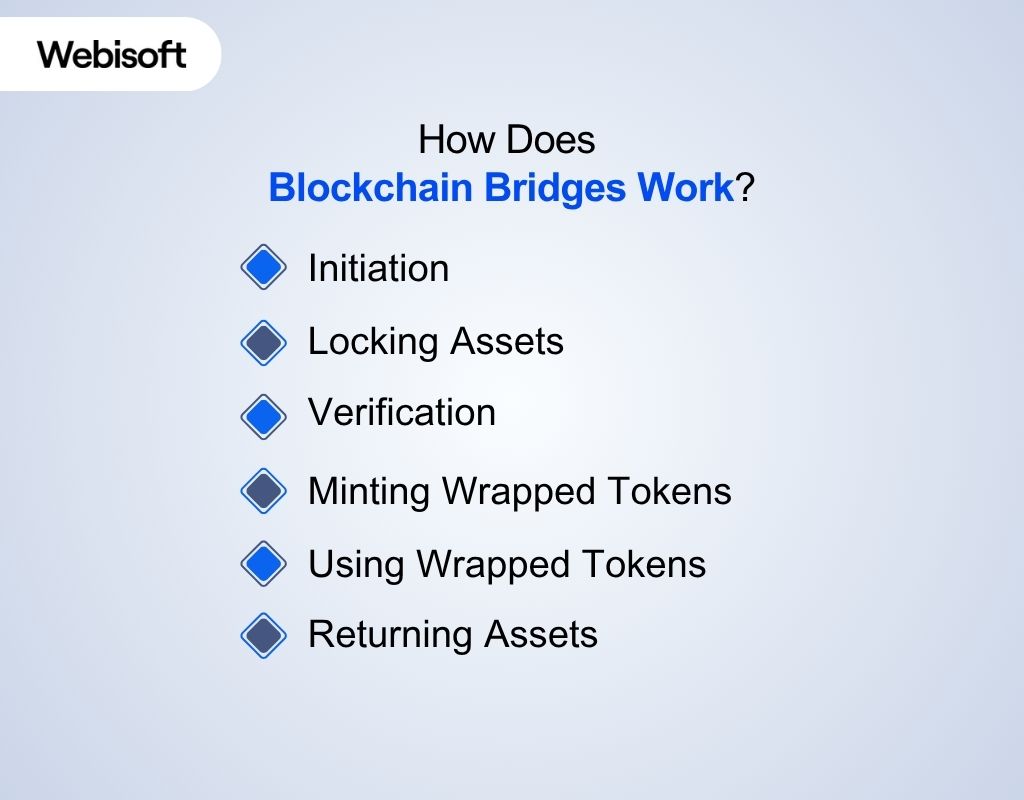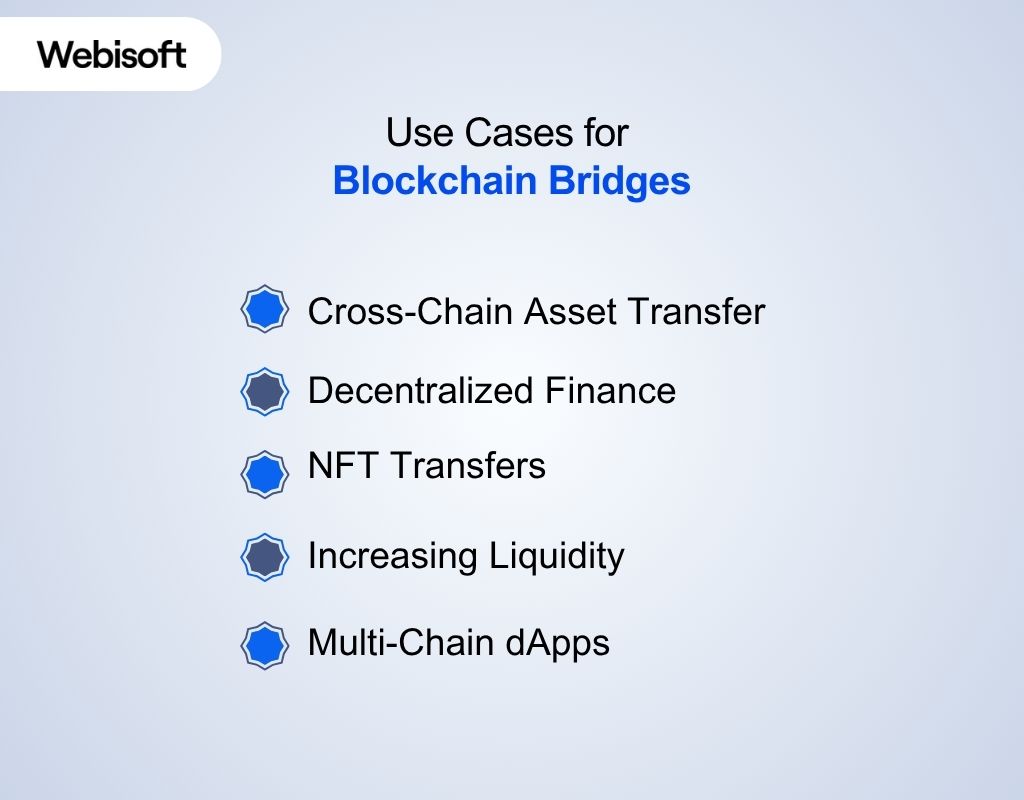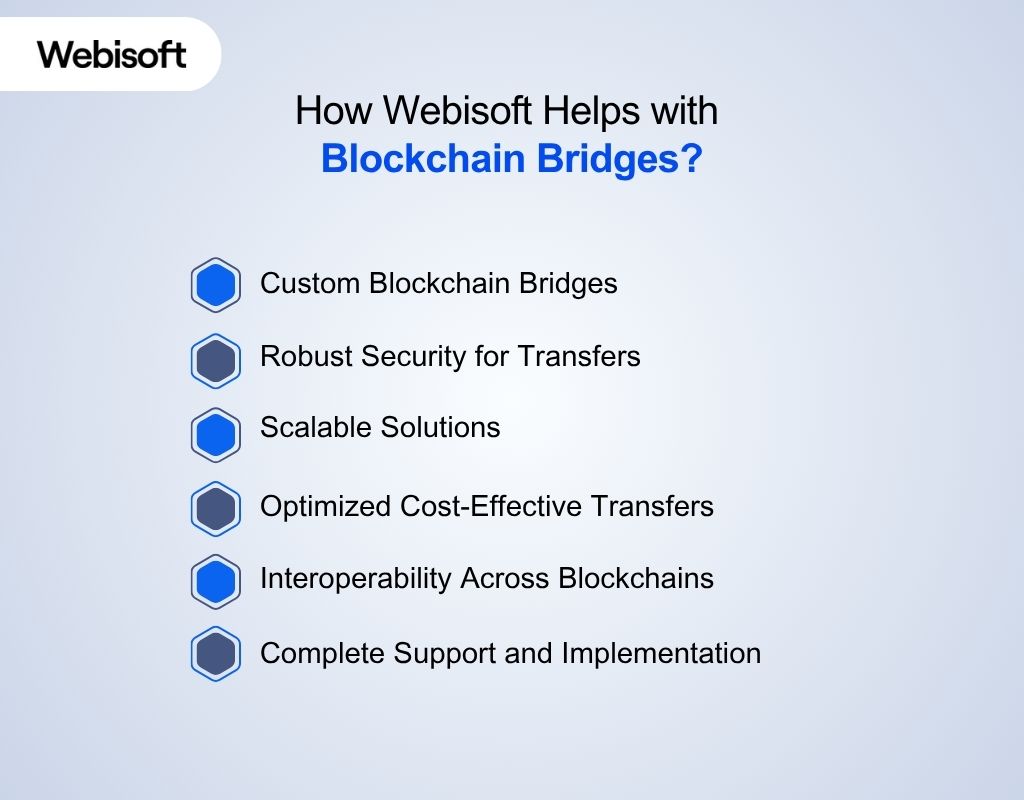What is a Blockchain Bridges: Meaning & Mechanism Simplified
- BLOG
- Uncategorized
- October 17, 2025
Beneath the surface of the blockchain world lies a hidden network of crucial connections, and that is blockchain bridges. They are likely silent highways where billions of dollars in digital assets travel every day.
It’s totally surprising how much these connections hold value. But yet, many don’t know what is a blockchain bridge?
Simply put, a blockchain bridge acts as a gateway that connects two independent blockchain networks. It enables the transfer of tokens and data between them despite their differing protocols.
But behind this powerful functionality lies a complex web of security challenges and vulnerabilities.
Contents
- 1 What Is A Blockchain Bridge?
- 2 How Does Blockchain Bridges Work?
- 3 Major Types of Bridges You Should Know About
- 4 Use Cases for Blockchain Bridges
- 5 Advantages of Blockchain Bridges
- 6 Start advanced blockchain integration with Webisoft
- 7 What Are The Biggest Blockchain Bridges?
- 8 Are Blockchain Bridges Safe?
- 9 Challenges of Bridging Blockchain
- 10 How Webisoft Helps with Blockchain Bridges?
- 11 In Closing
- 12 Frequently Asked Questions
What Is A Blockchain Bridge?
A blockchain bridge is a protocol that connects two separate blockchain networks, enabling them to transfer assets, data, and instructions between one another.
Most blockchains operate independently with their own consensus mechanisms, rules, and token standards, which makes direct interaction between them difficult. A blockchain bridge solves this problem by creating a secure link between otherwise incompatible networks.
For example, if you want to use Bitcoin on the Ethereum network, a bridge will lock your Bitcoin on its native blockchain and mint an equivalent token (such as Wrapped Bitcoin or WBTC) on Ethereum.This wrapped token represents the original asset and can be used within the Ethereum ecosystem.
By facilitating cross-chain functionality, blockchain bridges enhance interoperability, making blockchain networks more flexible, scalable, and useful for a wider range of applications. You can follow this blockchain bridge tutorial to understand how it works in action.
How Does Blockchain Bridges Work?

Blockchain bridges use various methods to move assets and data between two blockchains, with security and reliability as the main priorities. They create a secure path for blockchains to connect and allow communication between them.
Here are the core steps involved in a bridge transfer:
Initiation:
A user decides to move an asset (such as Bitcoin) from one blockchain (the source) to another blockchain (the destination). This can be done through a bridge platform.
Locking Assets:
The user deposits their asset into a smart contract on the source blockchain. This smart contract, controlled by the bridge, locks the asset and ensures it is no longer usable on the original chain. This prevents double-spending and ensures the asset is accounted for.
Verification:
Before assets are moved, the bridge first verifies that tokens are locked on the source chain. This prevents double-spending and ensures a secure transfer.
The verification process varies by bridge:
- Some use oracles, which are trusted services that detect the locked asset and relay that data to the destination chain.
- Others rely on validators or relayers, trusted nodes that monitor transactions and confirm the lock.
Once verified, the bridge mints or releases the equivalent token on the destination chain, completing the transfer securely.
Minting Wrapped Tokens:
Once the lock is confirmed, the bridge creates an equivalent asset on the destination blockchain. This is typically a wrapped token, like Wrapped Bitcoin (WBTC) on Ethereum.
The wrapped token represents the original asset and is pegged 1:1, meaning each wrapped token equals one unit of the original asset.
Webisoft works with businesses to develop custom token solutions that fit their specific blockchain environments.
Using Wrapped Tokens:
The user can now use the wrapped token on the destination blockchain. This means they can interact with decentralized applications (dApps) or participate in decentralized finance (DeFi). Or they even trade on exchanges within that blockchain’s ecosystem.
Returning Assets:
If the user wants to move the asset back to the source blockchain, they deposit the wrapped token into the bridge on the destination blockchain. The wrapped token is then burned (destroyed) and removed from circulation.
After burning, the original asset is released from the smart contract on the source blockchain and made available to the user again.
Major Types of Bridges You Should Know About
Blockchain bridges come in different forms, each designed for specific use cases. So, as with learning what is a blockchain bridge, get a quick understanding of these types of blockchain bridges. It helps you choose the best solution for your needs.
| Type | Key Traits | Primary Use Case | Examples |
| Chain-to-Chain | Directly links two blockchains | Simple token transfers between two networks | Polygon Bridge, Synapse |
| Multichain | Connects many blockchains via smart contracts | DeFi/NFT access across multiple chains | Stargate, Celer |
| Sidechain | Links the mainnet to the independent sidechain | Scalability and low-fee applications | Polygon (Ethereum), xDai |
| Centralized (Custodial) | Controlled by a single trusted party | Fast, easy token bridging with compliance | Binance Bridge, WBTC |
| Decentralized (Trustless) | Uses smart contracts and validators, no central control | Secure, non-custodial cross-chain transfers | RenBridge, Cosmos IBC |
| Federated | Managed by a group of pre-approved validators | Balanced speed and trust for DeFi/NFT platforms | Wormhole |
| Bidirectional | Supports two-way asset transfers | Reversible DeFi, NFT workflows | Avalanche Bridge, Wormhole |
| Unidirectional | One-way token flow only | Token migration, Layer-2 onboarding | Early Arbitrum Bridge |
| Programmable Token Bridge | Transfers tokens + triggers smart contract actions | Automate cross-chain swaps, staking, lending | Chainlink CCIP |
| Lock and Mint | Locks tokens, mints 1:1 wrapped versions | Move tokens to new chains with full backing | Polygon Bridge, Avalanche |
| Liquidity-Based | Uses token pools instead of wrapping | Fast, low-fee stablecoin transfers | Across, Stargate |
| Burn and Mint | Burns on one chain, mints fresh on another | Clean, trustless asset movement across chains | Circle USDC (CCTP) |
Use Cases for Blockchain Bridges

Blockchain bridges development opens many practical uses by connecting different blockchains. Here are some detailed use cases:
Cross-Chain Asset Transfer
Users move tokens or coins from one blockchain to another to access different networks or services. For example, by using the bridge, you can transfer Ethereum-based tokens to Polygon. It reduces transaction fees and speeds up transfers.
The bridge locks the original asset on Ethereum and issues a wrapped version on Polygon, making the token usable there without selling or converting.
Decentralized Finance (DeFi)
Bridges allow assets from one blockchain to participate in DeFi platforms on another chain. For instance, wrapped Bitcoin (WBTC) on Ethereum lets users take part in lending, borrowing, or yield farming without leaving the Ethereum ecosystem.
This expands DeFi’s reach by bringing liquidity and assets from multiple blockchains together.
With Webisoft’s expertise in DeFi development, businesses can integrate custom cross-chain solutions that offer seamless asset interaction across DeFi platforms
NFT Transfers
Some bridges support the movement of non-fungible tokens (NFTs) between blockchains. This lets NFT owners access different marketplaces or games that operate on various blockchains.
The NFT is locked on the original chain and minted or represented on the destination chain, maintaining ownership and provenance.
Increasing Liquidity
Bridges connect liquidity pools across blockchains, improving trading options and reducing slippage. By pooling assets from multiple chains, decentralized exchanges (DEXs) offer better prices and deeper liquidity.
This is especially useful for tokens that exist on several blockchains.
Multi-Chain dApps
Professional developers like those you will find at Webisoft build decentralized applications. They operate across several blockchains. Bridges allow these dApps to share data and assets between chains.
It creates a seamless experience for users who interact with multiple networks. This supports a more connected and interoperable blockchain ecosystem.
Advantages of Blockchain Bridges

Well, after that, you have the best understanding of what is a blockchain bridge, this is the time to know about its advantages:
Enhanced Interoperability
Bridges connect different blockchains, which causes assets and data to move freely between networks. This interoperability supports the growing DeFi market, projected to reach $42.76 billion in 2025.
Cross-chain bridges play a key role in linking fragmented ecosystems. It makes it easier for you as a user or developer to interact across multiple blockchains without restrictions.
Improved Scalability
By shifting transactions to faster or cheaper blockchains, bridges reduce congestion on busy networks like Ethereum. With expert development strategies from Webisoft, businesses utilize custom solutions and create cost-effective bridges as needed. It helps reduce exposure to high gas costs during peak times.
This scalability improvement makes blockchain use more practical for your everyday transactions and applications.
Increased Liquidity
Cross-chain bridges have moved billions in assets. Solana’s bridges saw over $10.1 billion in inbound volume in early 2025, a 114% increase from the previous year.
This growth shows how bridges improve liquidity flow across ecosystems. It grants decentralized exchanges and platforms access to deeper pools of assets for better trading and price stability.
Access to Diverse DeFi Protocols
Bridges connect your assets with multiple DeFi platforms, expanding your opportunities for lending, borrowing, and yield farming. This cross-chain access supports the rapid growth of DeFi, which depends on connected liquidity and assets.
You can maximize returns and diversify risk by interacting with protocols on different blockchains.
Streamlined Cross-Border Transactions
Bridges simplify the transfer of digital assets globally by cutting out intermediaries. This reduces costs and speeds up cross-border payments compared to traditional financial systems.
The direct transfer of assets between blockchains makes international transactions faster and more efficient, which benefits you whether you send money abroad or conduct international business.
It opens new possibilities for global commerce and remittances without relying on banks or payment processors.
Start advanced blockchain integration with Webisoft
Partner with us for custom blockchain bridge solutions.
What Are The Biggest Blockchain Bridges?
Some of the biggest blockchain bridges in 2025 are Symbiosis, Synapse Protocol, Stargate (LayerZero), Portal (Wormhole), and THORChain.
These bridges stand out for their wide chain support, security, speed, and user-friendly design.
- Symbiosis leads the market with support for over 30 blockchains, including Bitcoin, and more than 430 token pairs. It makes it one of the most comprehensive cross-chain solutions available.
- Stargate, built on LayerZero technology, offers fast and low-cost transfers, connecting major Layer 1 and Layer 2 blockchains efficiently.
- Wormhole remains a key player, especially for Solana, having processed $10.1 billion in total volume. However, newer bridges like deBridge are gaining ground with higher weekly volumes.
- Ethereum bridges dominate overall cross-chain activity, processing $38 billion in volume in a recent three-month span. It has far surpassed other networks.
Are Blockchain Bridges Safe?
Yes, blockchain bridges provide valuable connections between blockchains, but they come with notable security risks you should understand.
Many bridges have suffered hacks due to vulnerabilities in their smart contracts or centralized control points.
For example, in 2022, the Ronin Bridge lost $624 million after attackers compromised validator keys. Plus, Wormhole suffered a $320 million exploit because of a smart contract flaw.
These incidents highlight that bridges often concentrate large amounts of funds in one place, creating attractive targets for hackers.
Smart contract bugs, poor private key management, and centralization risks increase the chance of theft or loss.
To protect yourself, choose bridges with strong audit histories, start with small transfers, verify contract addresses, and monitor transactions closely.
If you are still concerned about blockchain bridge security, work with skilled and professional developers at Webisoft who have years of expertise in blockchain development.
They help design robust security measures and protect user assets from growing threats
Challenges of Bridging Blockchain
Building blockchain bridges faces several challenges that you should be aware of, especially if you plan to use them for cross-chain transfers. Along with what is a blockchain bridge, understanding these issues helps you navigate risks and make informed choices.
Security Vulnerabilities
Bridges often rely on complex smart contracts and sometimes centralized validators, which can be exploited by hackers. Choosing bridges that undergo regular security audits and use decentralized validators reduces the risk of losing assets to attacks.
Liquidity Management
If a bridge lacks enough liquidity on one side, your transfer might be delayed or fail.
Bridges that incentivize liquidity providers with rewards or maintain large multi-chain liquidity pools improve transfer success and speed.
That’s why understanding what is a blockchain bridge needs to function reliably. This is like sufficient liquidity is key to ensuring smooth cross-chain transactions and dependable access to your assets.
High Transaction Costs
Bridging assets can be expensive due to high gas fees, especially on networks like Ethereum. Using bridges connected to Layer 2 rollups or sidechains can lower these fees and speed up transactions, saving you money and time.
Complex User Experience
Many bridges require multiple steps and technical knowledge, which can be confusing. Bridges with simple, user-friendly interfaces and wallet integrations make it easier for you to move assets without hassle or mistakes.
Interoperability Limitations
Not all blockchains use the same standards, limiting which chains a bridge can connect. There are ongoing efforts to develop universal protocols and message-passing systems to improve compatibility. This will give you more options for transferring assets across different networks.
Regulatory Uncertainty
Changing laws and regulations can impact bridge operations and your access. Bridges that maintain transparent compliance and adapt quickly to legal changes help protect your assets and ensure continued service
How Webisoft Helps with Blockchain Bridges?

Efficient blockchain bridges are essential for connecting different blockchain networks effectively.
At Webisoft, we design and implement customized innovative blockchain solutions, including bridges that facilitate secure and efficient transfers between ecosystems. You can get new opportunities for businesses.
Custom Blockchain Bridges
We specialize in creating blockchain bridges for your specific needs. Whether you are transferring tokens or data, our solutions offer advanced interaction between different blockchain networks.
Robust Security for Transfers
Security is our top priority. Webisoft designs bridges with advanced security measures. We use cryptographic protocols and smart contracts to protect assets and data during the transfer process.
Scalable Solutions
As your business grows, our blockchain bridges adapt to handle increased traffic and expanding network requirements. We make sure your blockchain solutions remain efficient and scalable. You get long-term support as your needs evolve.
Optimized Cost-Effective Transfers
We focus on optimizing blockchain bridge solutions to reduce transaction costs. Our team works to make cross-chain transfers fast, secure, and cost-efficient. It makes your business operations more affordable and streamlined.
Interoperability Across Blockchains
Our blockchain bridges facilitate smooth interaction between various blockchain platforms. Whether integrating DeFi protocols or connecting diverse ecosystems, Webisoft makes certain that your assets move freely. You will get new avenues for growth and liquidity.
Complete Support and Implementation
At Webisoft, we provide end-to-end support for blockchain bridges. From initial consultation and design to seamless implementation and ongoing maintenance, we make sure that your bridge solution is reliable, secure, and easy to manage.
In Closing
Let’s recap: What is a blockchain bridge? It’s a technology that connects different blockchain networks and offers distraction-free transfers of assets and data.
These bridges are vital for businesses looking to enhance interoperability, security, and scalability across multiple blockchain ecosystems.
Whether it’s improving liquidity, reducing transaction costs, or ensuring faster processes, blockchain bridges are key to finding new possibilities in the decentralized world.
As a development company specializing in blockchain technologies, we’re passionate about building innovative solutions.
Contact us to discuss how our expertise with blockchain bridges can enhance your project’s interoperability and efficiency.
Frequently Asked Questions
1. Can blockchain bridges work with any blockchain?
Blockchain bridges typically support specific blockchains that share similar structures or have compatible protocols. However, newer bridges are being designed to connect diverse ecosystems across multiple blockchains.
2. What happens if a blockchain bridge fails during a transfer?
If a blockchain bridge fails during a transfer, the process may halt, and assets may remain locked. Well-designed bridges have contingency protocols in place to mitigate risks, such as reverting transactions or automatically restoring funds.
3. Can blockchain bridges help scale decentralized applications (dApps)?
Yes, blockchain bridges improve the scalability of dApps by allowing them to interact with multiple blockchains. This opens up opportunities for dApps to access greater liquidity, reduce transaction costs, and improve the overall user experience.
4. How do blockchain bridges affect transaction costs?
Blockchain bridges can reduce transaction costs by moving assets to blockchains with lower fees. For example, using a bridge to move tokens from Ethereum to a low-cost network like Polygon can significantly decrease the fees.


